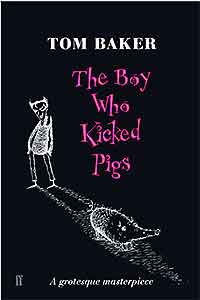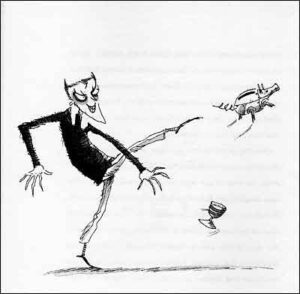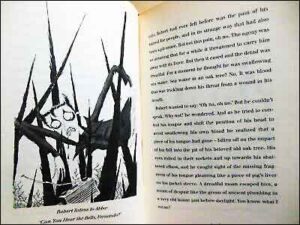By TOM BAKER (Faber and Faber; 1999/2006)
It’s never a good idea for a book to proclaim itself a “grotesque masterpiece” or “cult classic,” as it sets up unrealistic expectations (a great deal of the bad press that greeted the 1979 release of THE SHINING was, I’d argue, due to the ill-chosen poster tagline “A Masterpiece of Modern Horror”). Faber and Faber, however, used those superlatives on the front and back cover of the second edition of THE BOY WHO KICKED PIGS, a funny/horrific novella.
Tom Baker is best known for playing Dr. Who from 1974-81. With THE BOY WHO KICKED PIGS, illustrated in exaggerated Edward Gorey-meets-Gahan Wilson fashion by the prolific children’s book artist David Roberts, Baker showcased a Roald Dahl-eque sense of dark humor, paired with a very 1990s-centric air of macabre irony. Let’s not forget that 1999, the year of this book’s initial publication, marked the Columbine massacre, which THE BOY WHO KICKED PIGS, about a disturbed pre-teen boy on a rampage, unwittingly foreshadowed.
EXCERPT FROM BOOK
One day, it was in the summer, Robert was alone in the front room watching Postman Pat again and suddenly he was struck with the desire to kick a pig. His toes tingled and itched and his calf muscles fluttered. Robert was possessed. He opened the door and peeped around in case the dreaded Nerys was about the place. No sign of her and no sound of muttering from his mother in the kitchen. Robert nipped along to Nerys’s bedroom and fetched her pig Trevor, which she kept hidden in an antique chamber pot on top of her wardrobe. Nothing escaped Robert. He stood the pig on a wooden egg-cup, its snout towards the open window. It was a lovely warm day and conditions for kicking a pig were just perfect. Robert tucked a cushion under Trevor’s rump, retreated four paces and psyched himself up. There was a breathless hush in Vampire Close as Robert withdrew into himself in preparation for the kick of a lifetime. And then he burst into life and delivered a marvellous kick to Trevor’s arse. Again the pig flew. Out through the open window he went like an Exocet missile. A police car with its window wound down was cruising past the house at the very moment that Robert did his pig trick. The little tin creature carrying about two pounds and sixty pence in small coins in its stomach sailed through the cop car window.
That boy is Robert Caligari, who’s described as “a bit odd” and depicted as an Eddie Munster-esque weirdo with horn-shaped hair. His is a “very sad and terrible story” whose author admits upfront that “The story happened, and I have to write it down, so there. And if you decide to read the story, then good luck to you, I say.”
Robert C.’s outrages commence with the kicking of his sister’s tin piggy bank, which ends up destroying the family TV set. “Pig kicking” becomes Robert’s major preoccupation, resulting in the punting of another piggy bank, this time through the windshield of a police car in the first of two outrageously gruesome yet hilarious passages.
The second of those passages occurs after Robert decides he loathes humanity, throwing in his lot with, “The creatures that people hated and wanted to destroy…He would love the hated and hate the people.” Following some random troublemaking Robert attempts to shoot a horse-riding woman with a crossbow, which sets off an astounding chain reaction of destruction that results in many deaths and lands Robert in a deeply horrific, albeit karmically sound, predicament.
If this twisted account reminded me of anything it was the little-known Australian kid book BILLY THE MOST HORRIBLE BOY IN THE WORLD, which also offered a black-humored depiction of underaged psychosis with Edward Gorey-esque illustrations. THE BOY WHO KICKED PIGS is most assuredly not a kid’s book, although the language consciously imitates such writing, complete with references to “grown-ups” and illustrations that, as mentioned above, were accomplished by a children’s book artist. This novella might even have been intended as a spoof of such fare, although the nastiness of its imaginings and the ultra-bleak narrative arc are anything but parodic.



